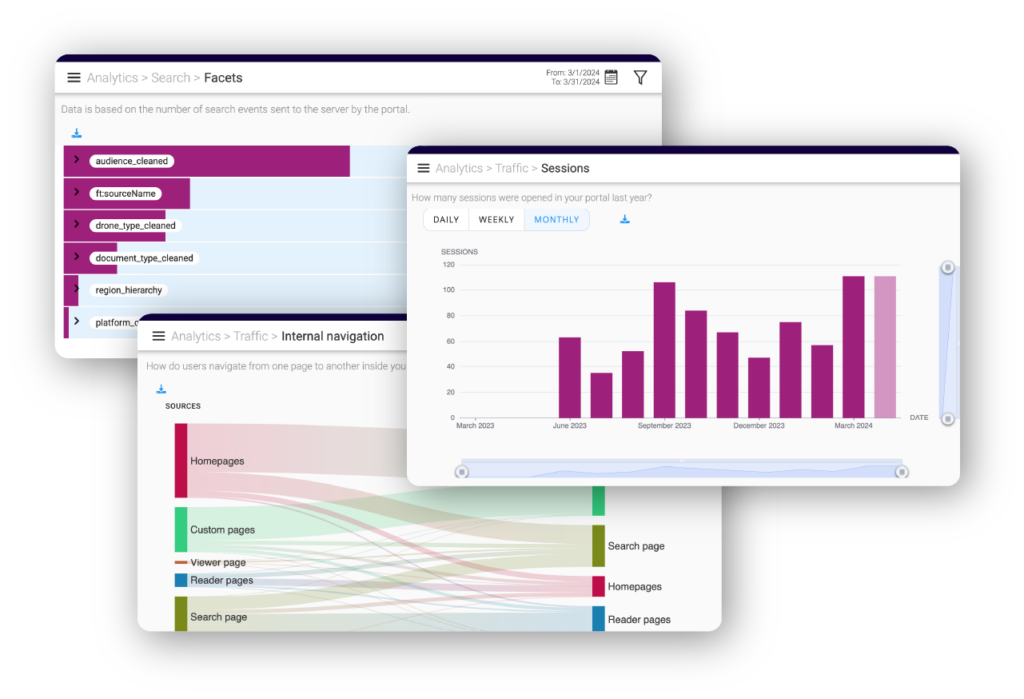Implementing a knowledge management system (KMS) is crucial for every company, and if you’ve ever struggled to find information as an employee or a customer then you understand why. 74% of organizations agree stating that implementing knowledge management best practices boosts the productivity of their teams by 10-40%.
In this blog, we’ve outlined everything you need to upgrade your organization’s knowledge management. First, explore the various people and parts of each step of this process to the benefits and challenges of knowledge management. Then to set you up for success, we share our latest insights on how to improve your knowledge management practices with Fluid Topics. To finish, we detail the most important metrics for measuring success and finding opportunities to improve your knowledge management.
Understanding the Basics of
Knowledge Management
Knowledge management refers to the process of producing, organizing, and sharing information and collective knowledge that helps employees and customers interact with the company’s products and services more efficiently.
Users can find knowledge in various types of content including customer support insights, technical documentation, training materials, FAQs, product comparisons, and more. There is also a lot of knowledge that companies can harness from firsthand employee experience; however, finding a way to extract and record this knowledge may be a challenge.

Businesses can support the creation of a KMS by establishing a knowledge base, which serves as a centralized location where information is easy to access.
Key Components of Knowledge Management
There are several people, processes, and technologies involved in creating and maintaining up-to-date company knowledge.
When producing knowledge content about the company’s products or services, typically technical writers work closely with subject matter experts to develop detailed documentation. Similarly, product teams create various product guides and charts that contain valuable information. These different teams use various authoring tools to produce their content, from MS Word to a CCMS, CMS, or other solution.
Beyond product knowledge, there are other teams that produce internal company knowledge like HR, Legal, and even IT teams. But for now, let’s focus on the lifecycle of technical product knowledge.
Once the teams have created product documents, they need to publish them. Then they must make them available to other employees and customers via a unified knowledge base or documentation portal. But just because the content is accessible doesn’t mean the job is done. From new offers to product updates and best practices, existing information needs continuous updating. In addition to regular content team updates, companies can implement feedback opportunities. This will help them better understand which documents are the most and least helpful. Both this and feedback from the customer support team are highly useful insights that help knowledge content creation teams optimize their outputs.
Types of Knowledge in Organizations
Within knowledge management, there are various types of knowledge and information to collect and share. Each variety is important to the success of a company.
Explicit Knowledge
Explicit knowledge is the information written down and published in documents such as product manuals, business reports, guides, studies, and more. Basically, the type of information we think about when we imagine a knowledge base. This kind of knowledge is essential for training employees, providing self-service solutions to customers, and retaining knowledge within a company.
Tacit Knowledge
Tacit knowledge refers to insights we gain through experiential learning, or hands on, personal experiences. This is difficult to put into words, making it challenging to formalize and document this kind of information. This includes knowledge such as learning other languages fluently, leadership skills, and having an eye for design.
Implicit Knowledge
Implicit knowledge is similar to tacit knowledge in that it is something people gain through experience. The difference is that implicit knowledge is often easier to document. It often refers to knowledge gained during operational processes and is identified as “know-how” information.

The Knowledge Management Process
There are three main steps to a successful knowledge management process, each one with its own challenges. Businesses need to consider all three when starting or optimizing their knowledge processes.
Knowledge Creation
The first step in enhancing a company’s knowledge management is generating knowledge content. There are different types of knowledge a business wants to collect. Depending on the kind, there are multiple teams of subject-matter experts with valuable information: product, legal, customer support, and more. These teams identify important information, and then technical writers need to document and update this knowledge in various types of places.
Knowledge managers and technical writers spend on average 50% of their time creating and preparing documents. Yet, without a document management strategy and a reliable system, 25% of these documents end up being lost.
Knowledge Storage
To ensure that documents are readily available and don’t become misplaced, companies need a centralized knowledge repository to store content for distribution. That means your knowledge management solution should gather 100% of your knowledge documentation. This includes gathering information in any format from all authoring and content management tools to create a unified knowledge center. That way, all knowledge content is centrally available for any authorized users.
Knowledge Sharing
Once your content is securely unified in a centralized knowledge base, you need to ensure users can access it from various end points and based on their permissions level.
Sharing knowledge is essential for business success. All the hard work goes to waste if the knowledge isn’t shared with everyone who needs it and used when it matters.
Benefits of Having an Enterprise
Knowledge Management System
From customer service to employee experience, here are some of the ways KMSs benefit organizations.
Improved Decision-Making
Knowledge management systems provide access to up-to-date, relevant knowledge for any given situation. As a result, both users and employees are able to make informed decisions about how to advance. A study by ResearchGate found that good knowledge management practices greatly improve an organization’s ability to make quick and effective decisions.
Increased Efficiency and Productivity
The longer it takes to get an answer, the harder it is for your users to be productive and the more frustration they may feel. With content accessible and easy to find in your knowledge management system, users can quickly and efficiently extract key information. They spend less time struggling to find the right documentation. Instead, they quickly troubleshoot issues before getting back to business as usual.
Customer Self-Service
With a solid knowledge management strategy and a central knowledge base, users can easily find the important information they need to continue with their day. By finding answers autonomously, customers engage in self-service where they solve their own issues without needing to contact a support agent. In addition to improving customer satisfaction, self-service reduces the volume of support tickets, allowing agents to focus on more complex issues that require personalized assistance.
Modern AI-enabled chatbots have also emerged as great assets in knowledge management systems. Many companies are upgrading their knowledge hubs with AI chatbots to offer more interactive conversations with users, enhancing their experience.
Challenges in
Knowledge Management Systems
Despite these benefits, there remain a few challenges that companies must overcome to achieve success.
Keeping Information Up-to-Date
Many companies face regular changes, from the quick pace of product launches to expansion into new countries. In the face of these shifts, keeping your knowledge up to date is difficult. However, knowledge maintenance and updates are essential. Otherwise, employees and customers will be frustrated at best and experience product downtime at worst with inaccurate, out-of-date content.
Technological Barriers
Another key challenge to knowledge management is identifying and eliminating any technical obstacles to creating a unified repository of product information. Companies must choose a solution that easily integrates with a wide variety of content sources and user endpoints. However, many authoring tools don’t seamlessly integrate with multiple endpoints.
Knowledge Management Systems vs.
Content Delivery Platforms
There are several key distinctions between the two types of systems:
A KMS helps organizations make the most of their collective knowledge by offering tools to create, organize, and find important information easily. It often works with other systems to make sure that accessing and sharing information is smooth and efficient.
In comparison, a Content Delivery Platforms (CDP) is a software solution that collects product knowledge from across sources and in any format, unifies it in one central knowledge hub, and then delivers it across various channels. Its primary goal is to make information accessible and engaging for end-users, often by structuring and formatting content in a way that enhances usability and relevance.
CDPs are also an essential knowledge management layer for AI applications.

While knowledge management involves the creation of content to document knowledge from various people and teams, CDPs don’t offer content creation tools. They extend the collaborative process of content creation across the organization by integrating a wider range of content types, such as Microsoft Word documents or Markdown files provided by stakeholders external to the documentation team.
With respect to delivery, both systems have distinct trajectories for how content moves and is shared. While KMSs engage in the exchanging of information between parties, CDPs work to deliver information from companies to users, both internal and external.
Another difference is in who the content in these systems is for. Companies often use knowledge management systems to provide content to internal teams. Depending on their KMS structure, they may also share beneficial product knowledge with external users through a knowledge base or help desk. On the other hand, Content Delivery Platforms deliver content to a plethora of users across touchpoints. Therefore, they require a strong user access management portal to define content access permissions for different types of user profiles.
It’s important to note that when choosing product knowledge tools and solutions, your choice isn’t either a CDP or a knowledge management system — they’re complimentary! CDPs are efficient at providing accurate, helpful content from KMSs to end users on the devices and at the touch points of their choosing.
How Content Delivery Platforms Bring
Knowledge Content to the Next Level
You may think that a series of documents, collaboration tools, and a knowledge base are sufficient for your company’s knowledge management. But there are several ways that CDPs optimize and enhance content operations and delivery. Here’s how Fluid Topics, a top Content Delivery Platform, takes your knowledge content to the next level:
- Easy integration: Fluid Topics offers seamless integrations for all your content sources and tools, whether it’s a tech doc team’s CCMS or a marketer’s Word document, helping to break down content silos. By effortlessly connecting with your existing systems, Fluid Topics ensures that your knowledge base, content repositories, and other tools work together smoothly.
- Intelligent Search: Each endpoint connected to Fluid Topics is also enriched with an AI-powered search engine to provide personalized and contextualized results.
- Content Freshness: CDPs help companies avoid outdated and inconsistent content. As soon as documentation is updated in an authoring tool connected to Fluid Topics, it is updated across touchpoints in a single click. Therefore, your documentation is always aligned with your product updates at any touchpoint.
- AI Applications: Easily configure and customize AI prompts to suit your business needs: generate content summaries, step-by-step instructions, product quizzes, and more. Fluid Topics integrates these capabilities into your knowledge base or customer portal so users can troubleshoot issues more efficiently.
- Case Deflection: Fluid Topics offers a modern case deflection tool to reduce the number of tickets that come your way with intelligent self-service recommendations. Prevent questions from turning into cases by providing suggestions directly from your documentation portal or knowledge bases. As a result, help your customers find solutions to their issues, accelerate resolution and increase your customer satisfaction score.
Measuring your Content Delivery Platform’s Success
Once you’ve connected your KMS to a CDP, you need to track your content’s performance to optimize your knowledge management efforts. Fluid Topics has several dedicated content analytics to provide the insights you need.
- Content Trends: Track the most and least popular documents and search terms to prioritize content writing. Investigate whether certain terms are less popular due to comprehension or because users use alternate search terms.
- Content Findability: Analyze keyword analytics to see what customers search for. Use the results to update your knowledge base with new metadata, taxonomies, and synonyms. As a result, improve content findability and usefulness.
- Searches with No Results: Pinpoint gaps in your knowledge content by tracking user searches that yield no results. If results don’t exist, have documentation teams produce new content or update existing content.
- Case Deflection Rate: Case or ticket deflection tracks the reduction in the number of support requests thanks to providing self-service options to customers.

Final Thoughts on Knowledge Management
Knowledge management is critical for companies of all sizes and across industries. The key is to centralize knowledge content into a unified repository. Here, the content is stored and later accessed through various endpoints for a cohesive content experience. To reap the many benefits of knowledge management and avoid the potential challenges, we recommend combining your KMS with an AI-powered Content Delivery Platform like Fluid Topics. Discover how to set up your user-friendly, smart knowledge base with Fluid Topics.
Latest post








